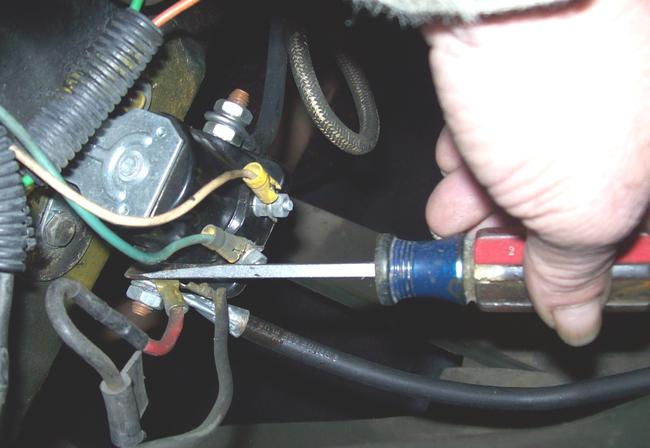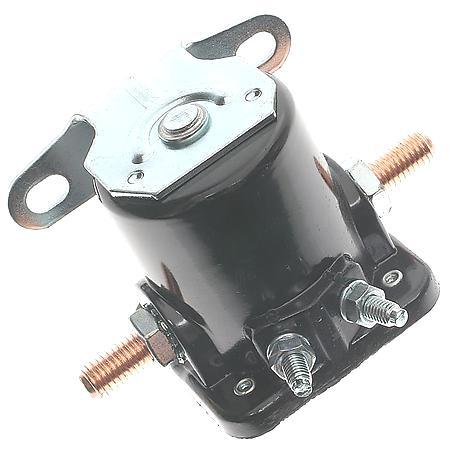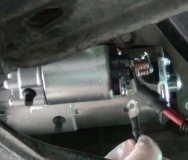SORRY---OUR SITE HAS NOT BEEN COOPERATING WITH ME
I HAVE ATTEMPTED TO ANSWER YOU FOUR TIMES---SEND PICS----IT JUST AIN'T HAPPENIN' YET!
ON MY PREVIOUS PICS A, B, C, D A AND B ARE INTERCHANGEABLE, AS LONG AS THE STARTER REMAINS BY ITSELF ON ONE SIDE OR THE OTHERON THE OPPOSING SIDE WILL BE THE POSITIVE BATTERY CABLE AND ANY ACCESSORIES THAT GET POWERED BY IT
MY PREFERENCE IS THE BATTERY CABLE AND ACCESSORIES BEING ON "A"THIS PUTS "C" (S-TERMINAL) RIGHT BESIDE THE POSITIVE BATTERY CABLE THIS MAKES IT REAL EZ TO "BUMP" OR EVEN "START" THE VEHICLE FROM UNDER THE HOOD USING A SCREWDRIVER (OR EVEN A REMOTE STARTER
TO "BUMP" THE KEY WOULD REMAIN OFF, OR COMPLETELY OUT OF THE SWITCHTO "START" THE KEY WOULD BE TURNED TO THE ON POSITIONTHEN "A" AND "C" WOULD BE CONNECTED USING A SCREWDRIVER
AS FAR AS YOUR SET UP----"C" IS THE ONLY TERMINAL THAT WHEN 12 VOLTS IS APPLIED WILL ACTIVATE THE SOLENOID (MAKE THE ELECTROMAGNET WORK) AND CONNECT "A" AND "B"
"D" (WHICH IS THE "I" TERMINAL) IS ACTUALLY "OUT GOING" 12 VOLTS FROM THE SOLENOID TO THE COILTHIS IS BASICALLY A "BOOST" OF JUICE FOR THE COIL WHILE THE STARTER IS SORTA ROBBING POWER FROM THE IGNITION SYSTEM DURING START UP."D" (OR "I") HAS NOTHING TO DO WITH MAKING THE SOLENOID ACTIVATE
IF YOU HAVE A FAILING NEUTRAL SAFETY SWITCH---IT MAY STILL CRANK IN "PARK" OR "NEUTRAL"
. OR IT MAY BE SHOT ALTOGETHER
IF YOU WANNA VERIFY THE PROBLEM IS ALONG THE WIRE LEADING BACK TO THE IGNITION SWITCH (IGNITION SWITCH, NEUTRAL SAFETY, THE WIRE ITSELF). ALL YOU GOTTA DO IS USE A JUMPER WIRE FROM THE POSITIVE SIDE OF THE BATTERY TO "C" ("S TERMINAL"). IF IT TURNS OVER, THE WIRE YOU HAVE ON THERE, IS EITHER THE WRONG ONE, OR IT IS NOT GETTING THE 12 VOLT SIGNAL THRU IT
SECTION C-8 SHOWS THE NEUTRAL SAFETY CONNECTOR (SHUNTED FOR A MANUAL TRANNY---AN ACTUAL SWITCH WOULD PLUG IN ON AN AUTOMATIC)
THE PROBLEM AT HAND IS. IT WILL NOT TURN OVER?
MAYBE THIS WILL COME THRU--AS WELL AS MY PICS
. SORRY 'BOUT YOUR FOOT
THE MEDIC
Image (Click to make bigger)
Monday, April 22nd, 2013 AT 12:22 PM






